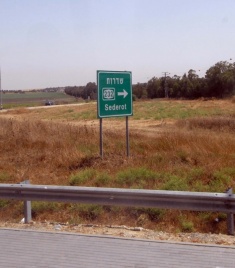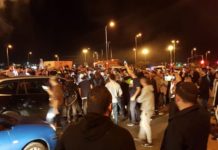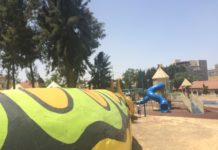
Thankfully, each time, I have been able to tell them that the alert has not sounded and no Qassams have hit Sderot during my stays. It has actually been about a week since the last rocket hit Sderot, which is a relatively long period of quiet here. And unlike some of my colleagues in the media, who feel cheated having visited Sderot and not witnessed an attack, I will be grateful to never hear the alert or experience an attack because every time the alert sounds and/or a Qassam hits Israel, somebody gets hurt — even if nobody is physically injured, the mental toll of each rocket is enormous.
So, the fact that no Qassams have come in to Sderot for nearly a week must mean that everything is ok, back to normal, cheerful, no fear, a sense of well being, right?
I guess that’s what all of us would like to believe.
In reality, though, it could not be further from the truth, as, in the wake of the relative quiet in Sderot, the surrounding area has come under heavy mortar fire. Two days ago, 18 mortars were fired at Israel, 10 of which landed in the same kibbutz. Yesterday, another barrage caused injuries to farmers while they were working the land around their kibbutz.
Unlike the case of Qasssams, in which the Tzeva Adom system detects the heat signature of the rockets and sounds the alarm, there is no way of detecting mortar fire and subsequently, no warning. The use of mortars has become more prominent, as they essentially achieve the same effect of terrorizing western Negev residents, while at the same time provide more fodder for the Hamas media relations departments to claim that Israel is using disproportionate amounts of force in their retaliations. Of course the media outlets jump at this, as there is nothing better for a quiet news day than pictures and footage that always seems to be readily available of dead or dying Palestinian women and children. There is seldom any mention of the fact that the mortars and other missiles are more often than not fired from residential homes, schools, nurseries and hospitals with the intention of using the people in these buildings as human shields, in the event of israeli retaliation.
Back in Sderot, where all is quiet, we have just celebrated the harvest festival of Shavout. I have put the cameras down for 25 hours and been invited for an evening meal and lunch the following day, by a family that lives by all the best traditions of the Jewish people. They decided a year ago to move to Sderot, when many thousands of others could not take it any longer and were leaving.
In addition to the day to day challenges of living in Israel, I feel humbled that the most pressing concern for this family is ensuring that I have somewhere to eat during the holiday.
To sit in a synagogue in Sderot during Chag Shavuot and carry out the priestly blessing as part of my duties as a Cohen is something that will always remain with me. Looking into the faces of the people around me, young and old, Sephardim and Ashkenazim, religious and secular, knowing that over the past seven years, many prayer services have been interrupted by sirens and even direct missile hits, I can almost see the burden they carry while living under such traumatic conditions; but each person has the determination to carry on their daily life with true spiritual belief.
At first, when I arrived in Sderot, I was constantly preoccupied with where the nearest shelter was located and what would happen if the terrorists fired Qassams while I was in the shower or,even worse, the toilet (a particular fear of mine). But now, I have my little routine of making sure that everything I may need is within reach. Even when I go to bed, I wear regular clothes just in case I have to run to the shelter. However, I am unable to prepare myself for the inability to sleep normally. Due to a mixture of explosions and machine gun fire within earshot and the memory of going through a night time missile attack nearly two years ago, I am a bit scared and feel helpless.
While I experienced an attack while in Nahariyah during the Second Lebanon War in 2006, I can’t help but feel guilty, as what I went through is nothing compared to the daily terror the people of Sderot have experienced the last seven years. In just the last three years, since the government disengagement from Gaza, Sderot has been on the receiving end of almost 3,000 rockets. I can’t imagine anywhere else in the world that endures anything similar to this without even the option of responding. In some ways, this period of relative quiet is worse than the constant barrages, during which at least everybody knows what is coming and what they must do. This quiet is not like the quiet of a cease fire at the end of a war. It is more of a twilight zone where they are just waiting with resignation for the next alert or explosion, contemplating where and when the next barrage of missiles will hit; will they be killed; will their apartments be hit; will the bus their children’s school bus or classroom take a direct hit?
For me, the single worst aspect of all this is looking into people’s eyes and seeing the havoc this has wreaked on their psyches. While much of the world looks at Israel as an oppressive occupying force that forces the Palestinians to live in refugee camps, I have seen that refugee status should not be reserved for Palestinians. I have seen Israelis displaced from their homes by rocket attacks and by the disengagement from Gaza, living in caravans, jobless and impoverished. But I do not see these people shooting rockets and mortars at innocent civilians or strapping explosives to their bodies and blowing themselves up in city centers.
You see a spirit in Sderot that other Israelis could do well to learn from. The people of Sderot endure unthinkable living conditions: families sleep together in the living room for fear of not being able to reach the shelter in time if they are upstairs; kids play in the park next to bomb shelters; hundreds of businesses have been forced to close their doors throughout the region; some people have experienced so many attacks, they can tell what kind of rocket and where it has landed just from hearing the explosion. Does this sound like the invincible Israeli oppressor Hamas apologists in the media talk about every day?
Although the living conditions are deplorable, and although the government has all but abandon these people to their fates, the spirit that helped create the state of Israel and the belief in god and miracles can still be found in Sderot.
“Each and every person in Sderot has experienced the trauma of a rocket exploding nearby,” said Sderot Media Center director Noam Bedein, who has been working harder than just about anybody to show the world what is happening in Sderot.
“People here have so much to tell and not many listeners. The more we listen, the more we tell, the more we can do for this traumatized town, the more people throughout the country and throughout the world will know what a small Jewish community under siege is going through. Do the people of Sderot stand alone? It is up to all of us to answer that question”.











